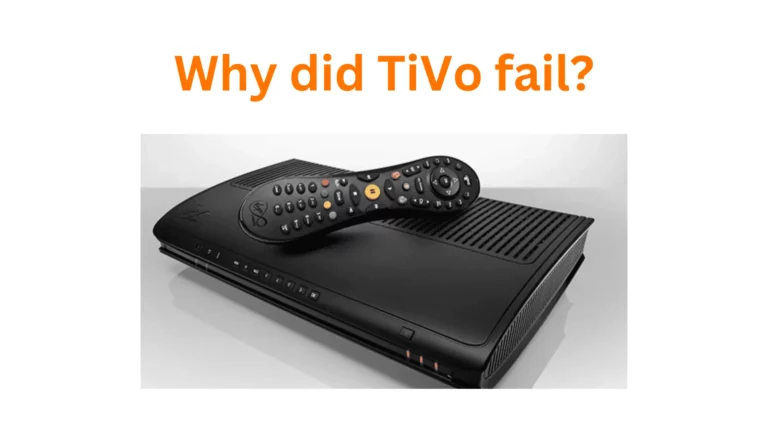When you search for TiVo on YouTube, you’ll immediately see a list of videos explaining how to troubleshoot one problem or another related to TiVo. It won’t take long to figure out why TiVo failed to work on customer pain points and provide a positive experience.
In case you don’t know, TiVo Inc., founded in 1999, is an American firm best known for its digital video recorder. It stores and records shows in the same way that a VCR does.
However, it includes several other characteristics that make it superior to a standard VCR, making it groundbreaking. For example, users could find and record shows that match their interests by title, actor, director, category, or keyword. The TiVo can store far more shows — hundreds of hours in most cases — since the hard drive is much more efficient than an old cassette tape.
Such creative features helped the company gain popularity among its customers. The idea behind launching TiVo was simply to optimize TV-watching for common folks.
And it worked for a while before it started crashing under competition and market pressure due to a lack of business innovation by the founders.
Let’s dissect the company’s failure
Here are the key factors that contributed to TiVo’s decline.
Market Competition
What made Tivo an immediate success was that it violated the rules of time. They enabled you to watch your favorite show when you wanted without having to wait for the show. It was the unique selling point of TiVo.
But TiVo failed to grab this opportunity and establish its authority.
TiVo soon had to face intense competition from cable and satellite TV providers who introduced their own DVR services with similar functionalities.
They went one step ahead and integrated these functionalities directly into their set-top boxes, making it feasible. Consumers now did not have to buy other hardware to enjoy such services.
At the same time, TiVo’s competitors also provided a sense of cost-effectiveness to their consumers by hiding the service fee in surging cable and satellite fees.
This led to TiVo’s gradual demise.
Changing Consumer Behavior
Netflix, Hulu, Amazon Prime Video, Hotstar, and other streaming platforms created a whole new customer segment.
Consumers now had access to on-demand content that they can stream anytime, anywhere.
TiVo just did not adopt this rising tech in its product.
And consumers no longer needed to record their favorite shows and movies. This caused a drastic drop in TiVo’s popularity.
Lack of Innovation
The fact is that TiVo still has an active B2B business with around 6000 patents to its name. But it no longer has any relevance for the end customers. People have moved on.
TiVo is now a part of studies that review why successful technologies failed even though they had high potential. And the research, as well as conversation on consumer / social forums, suggest it is because of the lack of innovation.
Related Read: Case studies of brands that went out of business due to lack of innovation.
When TiVo launched, significant technological advancements were already happening. Every business was focusing on continuous improvement and looking to innovate.
However, TiVo failed to innovate and market itself since people didn’t know what the product was or why they’d want it for years after its release.
Their story could have been different if they had focused on creating an innovation strategy that focused on:
- Ever-changing market landscape.
- Technological advancements.
- Establishing an innovation culture.
- Introducing new features and functionalities to the product as per consumer needs and demands.
- Strategizing for diversification. So, they can diversify service offerings and revenue streams to reduce dependency on a single market segment.
Intellectual Property Management
Personally, we believe TiVo’s biggest shortcoming was not being able to license its technology and user interface soon. They could not actively protect their patents and technology for broader usage.
When TiVo got involved in various patent disputes and infringement lawsuits, it helped them achieve licensing agreements and financial gains, $1.6 billion, to be exact. Experts believe it has sustained the company to this day. But it also diverted the company’s resources and attention.
Because they did not have a plan in place, they lost the race of innovation. Even if they had the chance to harvest inventions within their organization that could have helped lead the innovation race, they just did not have the right strategy and tools.
Not investing in intellectual property management can be expensive in the long run.
High Costs
We mentioned that TiVo’s competitors provided a sense of cost-effectiveness to their consumers by hiding the DVR fees in the surging cable and satellite fees.
Whereas TiVo’s hardware and service costs were high, they did not innovate on their pricing and value proposition as per new market requirements. This deterred potential customers from adopting TiVo. They’d rather get a DVR from their TV cable provider, who offered them the service at relatively low or seemingly no additional cost.
Lack of Partnerships
When cable companies decided to launch their own DVRs, TiVo wanted to secure strong partnerships and work out a deal with the TV providers. It was mainly because the product was reliant on the TV providers.
Therefore, instead of taking any legal action against the cable companies, TiVo initially waited and sought integration of its services more seamlessly with existing TV offerings. They hoped it would increase its reach and potential customer base.
However, they could not secure a deal.
So finally, when TiVo did sue, things were already out of hand, and cable company DVRs were everywhere.
Technological Advancements
While TiVo was a pioneer in DVR technology, it could not:
- Maintain a sound system with no or minimal technical errors. Customers felt frustrated by the level of technical problems they had to troubleshoot on a regular basis.
- Provide advanced features. TiVo’s competitors introduced new features and upgraded features to their DVRs, leaving TiVo behind.
- Create an intuitive and friendly user interface.
- Keep up with the ever-evolving technology advancements. For example, TiVo overlooked the rise of streaming services and expected users to keep recording and storing programs.
Customer Experience
Let’s start by reading a customer review of TiVo: Frequent errors like “HDMI not authorized,” “TiVo service not available,” and other system failures. I can’t count the times I’ve had to unplug/replug them (and wait through the whole start-up process) to make them work. And Netflix constantly crashes even though it works fine on the smart TV and other streaming devices.
This is only one of the examples of conversations, discussions, and complaints related to TiVo. The strangest thing is that TiVo didn’t even make an effort to help customers understand their value proposition.
Rather than marketing their unique features and the fact that TiVo boxes were better than cable DVRs, they chose to focus on one feature, i.e., commercial skipping.
And in the business world, where literally everyone considers their customer king, TiVo lost its vision amid all the chaos and competition. It ended up becoming the end of their retail segment.
According to ZDNet, “Both TiVo and Netflix were founded in 1997. At the end of 2004, Netflix had 2.6 million subscribers, roughly the same number as TiVo. At the end of 2007, when TiVo hit its peak of 4.4 million, Netflix had approximately 7.5 million subscribers. As of mid-2011, Netflix has around 25 million paid subscribers while TiVo has dropped to 2 million.”
This reminds us of the saying, “The graveyard of technology is riddled with failed products.”
Whereas TiVo’s competitors sailed through the turbulent and volatile market, it ended up being a case study for the emerging leaders from which they can learn and keep their company steady. Why TiVo failed is a case study for companies to learn from and stay relevant in the future.
Capture innovative ideas and stay ahead of the curve with InspireIP. Get your free trial today.



